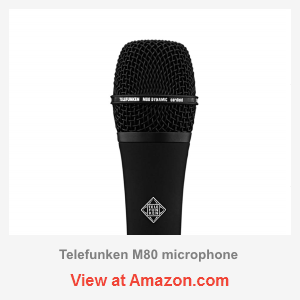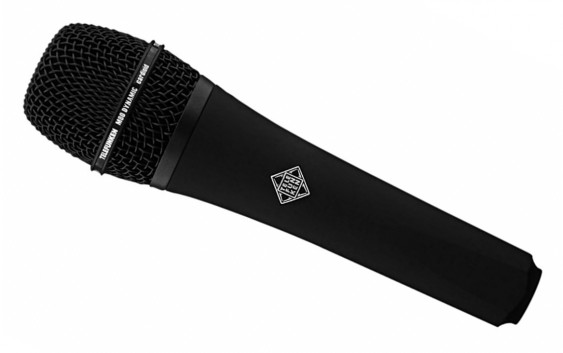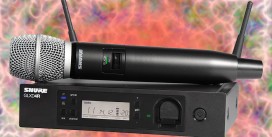Telefunken M80 is a rugged dynamic supercardioid mic for live vocals. It reminds of the well-known SM58, with a similar sound except for a better-balanced low-end response that helps it cut through the mix better. In terms of gain before feedback, there isn’t much of a difference either (when both are adjusted to the same levels) although it appears that M80 requires less gain despite the specs actually saying it has a lower sensitivity. Telefunken of course, is a well-known brand and it does not disappoint for making a mic that feels good and look good. The question is, are you ready to pay premium?
Sound & quality
Telefunken M80 indeed seems to resemble the sound of the old trusty Shure SM58 to a high degree; they have similar curves and behave in the same way. The only strong difference here is that the response of the M80 has less low end, in fact the frequency chart shows that it starts rolling off at 200 Hz, whereas Shure has it a little above 100. Ideally, we don’t want color especially when it comes to the low end, so one could expect that a flat curve is the way to go. However, this isn’t the case here, because these types of cardioid handhelds are inevitably affected by the proximity effect.
Therefore, when you hold the mic up close, the lows become significantly boosted and what was supposed to be flat response on the chart becomes significantly bumped and overblown, resulting in ‘mud’. The SM58 has always been suffering from this muddiness, causing a lot of disappointment and often times resulting in the vocalists struggling to be heard. Instead of producing clear voice there would just be this mud and rumbling. In this regard, Telefunken M80 is a big step up – the low end has a much better balance to it and the response becomes optimal at the actual close range of a handheld.
 In terms of clarity, the difference isn’t that big although the M80 is slightly superior, as there seems to be a bit more air to it. I wouldn’t call it as crispy as a condenser, it sounds rather smooth but the amount of detail is good regardless. There is also another difference between the two mics. The SM58 has a noticeable dip between 7 and 8 kHz whereas the M80 does not have it, which mean the latter is more accurate and requires less EQ. However, when this nuance is tackled the SM58 actually sounds almost identical. The similarity between the two is remarkable, which is good news for those loyal to Shure.
In terms of clarity, the difference isn’t that big although the M80 is slightly superior, as there seems to be a bit more air to it. I wouldn’t call it as crispy as a condenser, it sounds rather smooth but the amount of detail is good regardless. There is also another difference between the two mics. The SM58 has a noticeable dip between 7 and 8 kHz whereas the M80 does not have it, which mean the latter is more accurate and requires less EQ. However, when this nuance is tackled the SM58 actually sounds almost identical. The similarity between the two is remarkable, which is good news for those loyal to Shure.
Brand and build
Telefunken is a German brand, which has subsequently opened in the USA. It has a long history and legacy of producing some legendary mics – we can’t take that away from them. In modern times however, they seem to have been rebranding and modifying some of the Chinese mics. You can google the Apex 460 controversy, which lives to this day. Of course, they do have engineers to produce their own models, and the M80 reviewed is their original design but it seems to come at a premium cost. Consumers are convinced and are willing to pay extra for the mic that has a Telefunken logo on it.
For me, I don’t find it justifiable to pay two hundred and fifty bucks for a dynamic cardiod that doesn’t offer anything special from the technical standpoint. We have reviewed Heil PR 35 at around the same price, which really offers something different. It’s in its own league with its massive diaphragm that provides a dramatically deep low-end response and it’s priced accordingly. For the Telefunken M80 I just don’t find this to be the case. They even charge huge premium for their wooden and chrome designs. That being said, they indeed look pretty, feel solid and durable, meeting the definition of a reliable workhorse, albeit a bit pricey.
- Reviewed at $249.00
Pros
|
Cons
|










First must say so very glad to see the site back posting reviews on mics! I’ve long suspected Telefunken mics in general were overpriced, and I know I can get numerous excellent mics for a good bit less than this, but the affirmation is appreciated. You guys have such excellent reviews, please keep them coming!
This is junk – the version with the chrome grill literally rusted within a few weeks of use. There are numerous better dynamic vocal microphones – in fact everything reviewed here. Also, this is not the German Telefunken company this is a completely different company that bought the brand name only. Stay away from this as it is way overrated and designed to feather the pockets of Sweetwater sales engineers!
Respectfully disagree. This is the best sounding live mic I’ve ever heard or used. Not sure why the grill would rust … you drinking salt water?
I’m a professional live sound engineer . I think your off on this review and mislead a potential buyer. I own and use all the mics you mentioned weekly, normally 3-5 bands on a weekend. I think there are few similarities between a m80 and sm58 except that they are both vocal mics. First, regardless of what people say, the m80 is super Cardioid and will absolutely drop vocals that are off axis. The sm58 is fully cardioid and will pickup vocals from just about any direction and even from long distances. Useful for people with bad mic handling techniques. The m80 is exceptional for sound quality for most female and tenor vocals, also exceptional for gain before feedback. As for the Heil PR35 it has nice low end for male vocals, but feeds back easily, so the vocalist needs to be loud in live applications.
I own and use the Heil PR 35 and can attest to it’s 40db of rear rejection resulting in very low feedback. I have used it for live room recording with very little bleed. I can’t speak concerning the Telefunken M80 having no experience with it. I am sure it is a respectable piece of kit however, the PR 35 outperforms anything I have ever used in a live situation, beautiful, full and clear and as I said fantastic rear rejection.
Best Mic I have ever used.